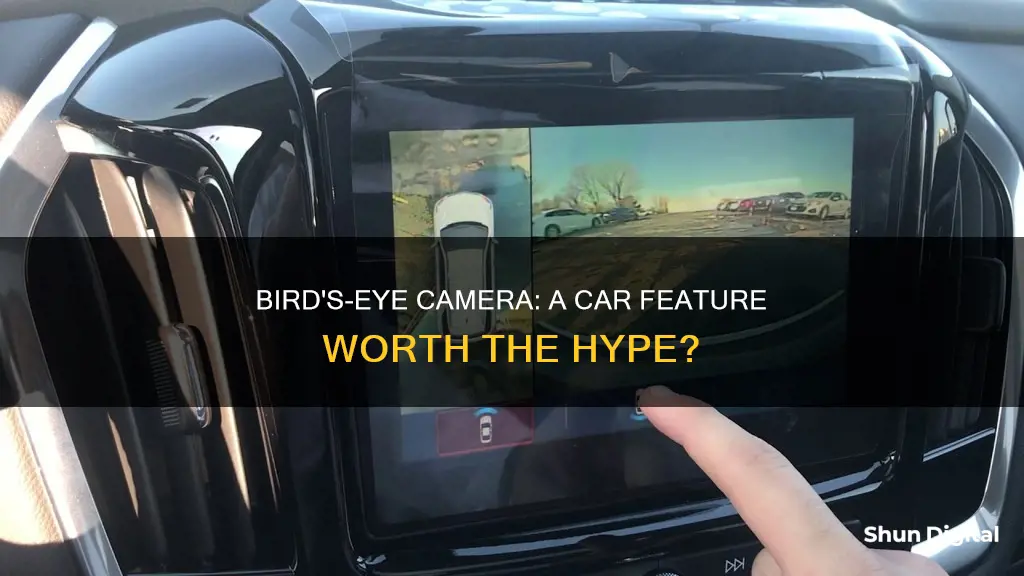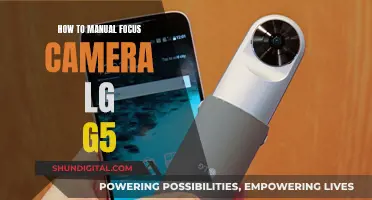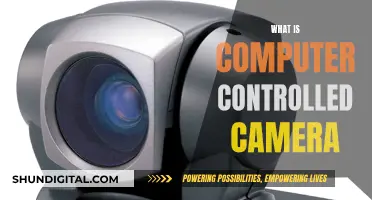
A bird's eye camera system for a car is a technology that provides a top-down composite view of the vehicle and its surroundings, as if viewed from above. This is achieved by stitching together images from multiple cameras positioned around the vehicle. The resulting bird's eye view is displayed on a monitor, typically activated when the vehicle is put into reverse gear, and can be invaluable when parking, especially in tight spaces or when parallel parking. Some users have described it as a game-changer when parking, and it can also help to reduce blind spots and improve safety. However, it is typically an expensive add-on, often only available on higher trim levels or as part of a premium package. So, is it worth it? Well, that depends on the cost and the value it brings to the individual. For those with a history of fender benders when parking, or those who frequently navigate tight spaces, it could be a valuable investment. For others in more rural areas with ample parking space, it may not be as essential.
| Characteristics | Values |
|---|---|
| Number of Cameras | 4 or 6 |
| Camera Locations | Front, rear, and side-view mirrors |
| Image Processing | Computer-assembled and synthesized |
| View Options | Bird's Eye View, Split-Screen, Curb View, Front View |
| Use Cases | Parallel parking, tight turns, parking garages, off-roading |
| Advantages | Easier parking, reduced blind spots, improved safety |
| Cost | $900-$1,200 as a stand-alone option |
What You'll Learn

A bird's-eye view camera is a valuable safety feature
The bird's-eye view is created by stitching together images from multiple cameras positioned at different angles around the vehicle. This computer-generated image offers a unique perspective that helps drivers visualise their car's position relative to surrounding objects. This is especially useful when backing into or out of parking spaces, as it reduces blind spots and allows for more precise movements.
One of the biggest advantages of a bird's-eye view camera is its ability to assist in parallel parking. This challenging task often induces anxiety in drivers, but with the bird's-eye view, they can confidently see the car's position relative to the curb and parking lines. No more guessing or worrying about scratches and dents!
In addition to parking, bird's-eye view cameras offer benefits in various driving scenarios. When making tight turns, drivers can see exactly where their vehicle is in relation to obstacles, ensuring they clear them without needing to back up repeatedly. This feature is also invaluable for larger vehicles with significant blind spots, such as commercial vans or trucks, helping them navigate busy streets and crowded areas with better awareness.
While bird's-eye view cameras are often considered a luxury or high-end feature, their safety benefits cannot be overstated. They enhance the driver's situational awareness, reduce the risk of accidents, and provide peace of mind, especially in urban areas with limited parking spaces. For drivers with a history of fender benders or those who frequently navigate tight spaces, this technology can be a true game-changer, making it well worth the investment.
Reviving Your Camera Battery: Charging from Zero
You may want to see also

It helps with parking, especially in tight spaces
Parking a car, especially in tight spaces, can be a daunting task. It requires judgement and skills that many people seem to lack. This is where a bird's-eye view camera comes in.
A bird's-eye view camera system, also known as a surround-view camera system, offers a top-down view of a car and its surroundings. This system uses four to six cameras positioned at the front, rear, and sides of the vehicle to capture exterior angles. The images from these cameras are then stitched together by an image-processing system to create a composite, 360-degree view. This technology provides drivers with a better understanding of their surroundings, making parking in tight spaces much easier.
One example of this technology is Toyota's Bird's Eye View camera system, which includes a Perimeter Scan feature. This feature provides drivers with a live 360-degree view of the exterior of their vehicle, helping them to navigate in and out of tight spaces. The system can be activated automatically when the vehicle is put into reverse, or manually by pressing a button. In addition to the bird's-eye view, the system also offers a split-screen view, a curb view, and a front view, all of which can aid in parking.
Another benefit of bird's-eye view camera systems is their ability to reduce blind spots. This is especially useful for commercial vehicles with large blind spots, such as large vans or trucks. By providing a top-down view, these camera systems can help drivers see obstacles that would otherwise be hidden from view, making parking and manoeuvring much safer.
Overall, a bird's-eye view camera system can be incredibly valuable for drivers, especially when it comes to parking in tight spaces. It provides a unique perspective that enhances visibility and awareness of the vehicle's surroundings, making parking a much less stressful task.
Mastering Camera Care: Handling Your Device with Precision
You may want to see also

It reduces blind spots
A bird's-eye camera system in a car is extremely valuable as it reduces blind spots. This technology, also known as a surround-view camera system, provides a top-down view of the car and its surroundings, giving the driver a perspective as if they were hovering over the vehicle.
These camera systems typically consist of four strategically placed cameras that capture front, rear, and side exterior angles. The images from these cameras are then stitched together by an image-processing system to create a composite view. This results in a lifelike, yet synthetic, bird's-eye view that helps drivers navigate and manoeuvre their vehicles more effectively.
One of the biggest advantages of bird's-eye camera systems is their ability to reduce blind spots significantly. Commercial vehicles with large blind spots, such as vans or trucks, can greatly benefit from these systems. By providing a top-down view, drivers can easily see their vehicle's surroundings, including any obstacles or hazards that may be present. This is especially useful when navigating tight spaces, such as parallel parking or manoeuvring in crowded areas.
Additionally, modern surround-view camera systems offer multiple viewing options. Drivers can select different camera angles to get a better view of the vehicle's sides, what's in front of the car below the field of vision, or directly behind it. This versatility enhances the driver's situational awareness and further reduces blind spots.
The bird's-eye view, combined with the ability to switch to different camera angles, empowers drivers to make more informed decisions and navigate their vehicles with increased confidence and safety. This technology is particularly advantageous in challenging situations, such as pulling out of a blind alley onto a busy street or navigating off-road terrain.
In conclusion, bird's-eye camera systems in cars are incredibly valuable as they significantly reduce blind spots. By providing a top-down view and multiple viewing options, drivers gain a better understanding of their surroundings, leading to improved decision-making and safer driving experiences.
Understanding Raw Camera Link Data: Unlocking the Power
You may want to see also

It's a useful feature for larger vehicles
A bird's-eye view camera is a useful feature for larger vehicles. These cameras can help drivers of larger vehicles see everything from above, like a bird, which is especially useful when trying to park a big car in a small space. This technology can also help with other tricky driving situations, such as pulling out of a blind alley onto a busy street.
The bird's-eye view is created by stitching together images from multiple cameras positioned around the vehicle. These cameras are usually wide-angle lenses that capture the front, rear, and side exterior angles. The images are then stitched together by an image-processing system to create a lifelike, synthetic, top-down view of the vehicle and its surroundings.
This technology can be particularly useful for larger vehicles that have larger blind spots. For example, a large step van with a divider behind the cab would benefit from a bird's-eye view camera as it would provide visibility where there are no rear windows.
In addition to the top-down view, bird's-eye view camera systems can also offer different camera view options. For instance, the driver can choose to see the passenger's side of the vehicle, what's in front of the car below the field of vision, or what is directly behind it. This can be incredibly advantageous in various driving situations.
Some bird's-eye view camera systems also include guidelines superimposed onto the image shown on the infotainment display. These guidelines can show the vehicle's current orientation and expected direction of travel based on gear selection and steering-wheel angle. This can be especially helpful for larger vehicles when navigating tight spaces.
Overall, a bird's-eye view camera can be a valuable feature for larger vehicles, providing enhanced visibility and awareness of the surrounding environment, which can lead to safer and more confident driving.
Charging Your Panasonic Lumix DMC-FZ70 Camera Battery: A Guide
You may want to see also

It's a good feature for off-roading
A bird's-eye view camera system is a valuable feature for off-roading. This technology, also known as a 360-degree camera, provides a top-down composite view of the vehicle and its surroundings. This can be incredibly useful when navigating off-road terrain, as it allows the driver to see objects and obstacles that may not be visible from the driver's seat. This includes rocks, steep inclines, and other hazards that are typically encountered when off-roading.
The bird's-eye view is created by stitching together images from multiple cameras positioned around the vehicle. These cameras capture front, rear, and side exterior angles, which are then processed and synthesised by an image processing system to create a lifelike, yet synthetic, top-down view. This technology is now offered by many automakers and is particularly useful for larger vehicles with limited visibility.
Off-road vehicles can utilise this technology to aid in rock-crawling or navigating steep inclines. The bird's-eye view helps drivers make more informed decisions when navigating challenging terrain. Additionally, the camera system can provide guidelines on the infotainment display, showing the vehicle's current orientation and expected direction of travel. This information can be crucial when manoeuvring in tight or hazardous off-road situations.
The bird's-eye view camera system enhances safety and confidence when off-roading. It reduces blind spots and provides a clearer understanding of the vehicle's surroundings. This technology is especially advantageous for off-road enthusiasts, who often encounter unpredictable and challenging terrain. With the bird's-eye view, drivers can better assess the environment and make more precise manoeuvres, ensuring a safer and more enjoyable off-roading experience.
Overall, the bird's-eye view camera system is a valuable tool for off-roading. It improves visibility, assists in navigating obstacles, and enhances safety measures. This technology is a great asset for off-road drivers, providing a unique perspective that can make all the difference in handling diverse off-road conditions.
Streamlining Logistics: Cameras to Computers
You may want to see also
Frequently asked questions
A bird's-eye camera system gives a live 360-degree view of a vehicle and its surroundings, providing a top-down perspective as if viewed from above.
A bird's-eye camera uses four or more cameras positioned at the front, rear, and sides of a vehicle to capture images of the exterior. These images are then stitched together by an image-processing system to create a composite 360-degree view.
A bird's-eye camera improves safety and makes parking easier, especially in tight spaces or when parallel parking. It reduces blind spots and helps drivers see obstacles, vehicles, and pedestrians around their car.
The bird's-eye camera is considered a valuable feature, especially for larger vehicles and those with poor visibility. While it is an expensive add-on, many users find it to be a game-changer for parking and manoeuvring in tight spaces.
Several automakers offer bird's-eye camera systems, often as an option on higher trim levels or in package deals. Examples include Toyota, Nissan, Hyundai, Mitsubishi, and Lincoln.







